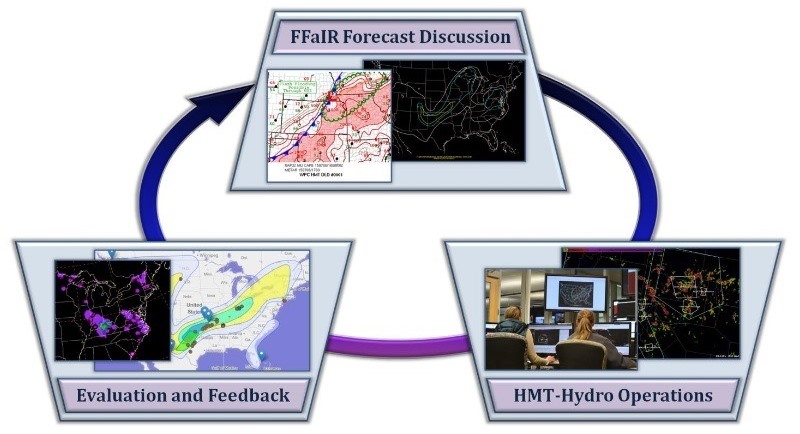In the HMT-Hydro Experiment, NSSL scientists and NWS forecasters came together to evaluate new tools and techniques through real-time testbed operations for the improvement of flash flood detection and warning operations. The HMT-Hydro Experiment assessed the use of MRMS and FLASH products in flash flood operations along with the use of probabilistic information in flash flood watches and warnings.
HMT-Hydro 2019
The Hydrometeorology Testbed (HMT) Multi-Radar / Multi-Sensor (MRMS) Hydro Experiment (hereafter, “HMT-Hydro”) continues with its efforts from 2018 on the use of probabilistic information and short-term quantitative precipitation forecasts (QPFs) to improve the prediction and warning of flash flood events. Continued funding from the NOAA Office of Water and Air Quality (OWAQ) will allow NSSL scientists and NWS forecasters to collaborate on the next evolution of hydrologic modeling and flash flood prediction.
The 2019 HMT-Hydro Experiment will again use both real-time experimental warning operations and archived case evaluations to to investigate the use of probabilistic grids and QPFs for flash flood warning decision making. This includes the pairing of the hydrologic modeling within the FLASH system and the Warn-on-Forecast storm-scale precipitation forecasts. This year will also include the first analysis of a probabilistic quantitative precipitation estimation (QPE) product suite based on MRMS QPEs. HMT-Hydro Experiment activities will begin June 24, 2019 and will be conducted over three different weeks ending on July 19, 2019.
- 2019 HMT-Hydro Experiment Operations Plan (PDF — Version 1.1)
- 2019 HMT-Hydro Experiment Executive Summary (PDF — Version 1.0)
- 2019 HMT-Hydro Experiment Final Report (PDF — Version 1.0)
HMT-Hydro 2018
The Hydrometeorology Testbed (HMT) Multi-Radar / Multi-Sensor (MRMS) Hydro Experiment (hereafter, “HMT-Hydro”) is returning in 2018 with new objectives and experimental techniques for predicting flash flooding. Funding from the NOAA Office of Water and Air Quality (OWAQ) will allow NSSL scientists and NWS forecasters to collaborate on the next evolution of hydrologic modeling and flash flood prediction that integrates probabilistic information and uncertainty into the warning decision making process.
The 2018 HMT-Hydro Experiment will utilize both real-time experimental warning operations and archived case evaluations to investigate the use of probabilistic grids and quantitative precipitation forecasts for flash flood warning decision making. This includes the pairing of the hydrologic modeling within the FLASH system and the Warn-on-Forecast storm-scale precipitation forecasts. HMT-Hydro Experiment activities will begin June 25, 2018 and will be conducted over three different weeks ending on July 20, 2018.
- HMT-Hydro Experiment Operations Plan (PDF)
- HMT-Hydro Experiment Executive Summary (PDF — Version 1.1)
- HMT-Hydro Experiment Final Report (PDF — Version 1.1)
For references to the current operational suite of the FLASH products, which are the baseline products in the HMT-Hydro Experiment, please review the following lessons created by the NWS Warning Decision Training Division (WDTD):
HMT-Hydro 2016

The Multi-Radar / Multi-Sensor (MRMS) Hydro Experiment (hereafter, “Hydro”), which is a part of the 2015 United States Weather Research Program (USWRP) Hydrometeorological Testbed (HMT), will be conducted in conjunction with the Flash Flood and Intense Rainfall (FFaIR) Experiment at the Weather Prediction Center (WPC) from 20 June to 15 July.
During the experiment, National Weather Service and River Forecast Center forecasters will work with research scientists to assess emerging hydrometeorological concepts and products to improve the accuracy, timing, and specificity of flash flood watches and warnings. In particular, forecasters will evaluate short-term predictive tools derived from MRMS quantitative precipitation estimates (QPE) and Flooded Locations and Simulated Hydrographs (FLASH) hydrologic modeling framework. The Hydro Experiment will also explore the utility of experimental watch and warning products conveying uncertainty and magnitude issued through the Hazard Services software. This allows research scientists to investigate human factors to determine operationally relevant best practices for the warning decision making process and the system usability of the Hazard Services platform. Operational activities will take place during the week Monday through Friday.
For Participant Use
- Daily Evaluation Questionnaire
- Exit Survey
2016 Tales from the Testbed
HMT-Hydro 2015
The Multi-Radar / Multi-Sensor (MRMS) Hydro Experiment (hereafter, “Hydro”), which is a part of the 2015 United States Weather Research Program (USWRP) Hydrometeorological Testbed (HMT), will be conducted in conjunction with the Flash Flood and Intense Rainfall (FFaIR) Experiment at the Weather Prediction Center (WPC) from 6 July to 24 July.
During the experiment, National Weather Service and River Forecast Center forecasters will work with research scientists to assess emerging hydrometeorological concepts and products to improve the accuracy, timing, and specificity of flash flood watches and warnings. In particular, forecasters will evaluate short-term predictive tools derived from MRMS quantitative precipitation estimates (QPE) and Flooded Locations and Simulated Hydrographs (FLASH) hydrologic modeling framework. The Hydro Experiment will also explore the utility of experimental watch and warning products conveying uncertainty and magnitude issued through the Hazard Services software. This allows research scientists to investigate human factors to determine operationally relevant best practices for the warning decision making process and the system usability of the Hazard Services platform. Operational activities will take place during the week Monday through Friday.
For Participant Use
2015 Tales from the Testbed
HWT-Hydro 2014
Between July 6th, 2014 and August 1st, 2014 we hosted the Hazardous Weather Testbed-Hydrology (HWT-Hydro) experiment focusing on issues surrounding warnings for flash flooding. This experiment was conducted in coordination with the HMT/Flash Flood and Intense Rainfall (FFaIR) experiment hosted by the Weather Prediction Center (WPC).
- 2014 HWT-Hydro Final Report
- HWT-Hydro Operations Plan (PDF)
- HWT-Hydro Evaluation Questions (PDF)
- FLASH Products (PDF)
- FLASH Products (Printable PDF)
